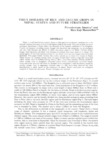Virus Diseases of Rice and Legume Crops in Nepal: Status and Future Strategies
Tropical agriculture research series : proceedings of a symposium on tropical agriculture researches
| ISSN | 03889386 |
|---|---|
| 書誌レコードID(総合目録DB) | AA00870529 |

本文フルテキスト
tars19-_3-13.pdf2.13 MB
Nepal, a small land-locked country, shows a wide spectrum of climatic variation due to the altitude ranging from near sea level to the highest peak in the world. The types of plant parasitic pathogens prevailing in Nepal reflect the diversity in the climatic conditions in the Kingdom. Twenty six diseases including twenty fungal, two bacterial, one nematode, one physiological and two viral diseases are known to affect rice (Oryza sativa L.) in Nepal, whereas sixteen fungal, three bacterial and three viral diseases of soybean have been observed in Nepal. The causal agents of two virus diseases of rice viz. rice dwarf virus and rice tungro virus have been identified. This paper briefly reviews the studies carried out on these two viruses in Nepal. Three viruses viz. soybean mosaic virus, the agent of bud blight (tobacco ring spot virus) and yellow mosaic virus of soybean (Glycine max (L.) Merr.), have been reported. Disease caused by yellow mosaic virus in mungbean (Phaseolus aureus Roxb.), proliferation (cucumber mosaic virus) and stunt (pea leaf roll virus) in chickpea (Cicer arietinum L.) and the disease caused by sterility mosaic virus in pigeonpea (Cajanus cajan (L.) MIl) have been observed but their identification is solely based on the symptoms on plants. Major constraints on virological research in Nepal are discussed. Future strategies are outlined.
| 刊行年月日 | |
|---|---|
| 作成者 | Purushottam Amatya Hira Kaji Manandhar |
| 公開者 | Japan International Research Center for Agricultural Sciences |
| 巻 | 19 |
| 開始ページ | 3 |
| 終了ページ | 13 |
| 言語 | eng |
